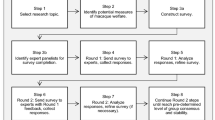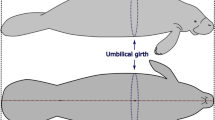Abstract
The nutritional status of individual monkeys in research projects is an important yet sometimes overlooked variable that complicates the interpretation of research findings. The authors offer a framework for scoring fatness and muscularity in a semiquantitative manner without special equipment and in a way that could easily be accomplished during a routine physical examination. Body condition scoring can be used to assess the health of individual animals as well as determine nutritional adequacy within groups of animals.
This is a preview of subscription content, access via your institution
Access options
Subscribe to this journal
We are sorry, but there is no personal subscription option available for your country.
Buy this article
- Purchase on Springer Link
- Instant access to full article PDF
Prices may be subject to local taxes which are calculated during checkout


Similar content being viewed by others
References
Burkholder, W.J. Use of body condition scores in clinical assessment of the provision of optimal nutrition. J. Am. Vet. Med. Assoc. 217(5), 650–654 (2000).
Donoghue, S., Khoo, L., Glickman, L.T. & Kronfeld, D.S. Body condition and diet of relatively healthy older dogs. J. Nutr. 121(11 Suppl), S58–S59 (1991).
Foltz, C.J. & Ullman-Cullere, M. Guidelines for assessing the health and condition of mice. Lab Anim. (NY) 28(4), 28–32 (1999).
Kronfeld, D.S., Donoghue, S. & Glickman, L.T. Body condition and energy intakes of dogs in a referral teaching hospital. J. Nutr. 121(11 Suppl), S157–S158 (1991).
Kronfeld, D.S., Donoghue, S. & Glickman, L.T. Body condition of cats. J. Nutr. 124(12 Suppl), 2683S–2684S (1994).
Laflamme, D. Development and validation of a body condition score system for cats: a clinical tool. Feline Pract. 25(5/6), 13–18 (1997).
Laflamme, D. Development and validation of a body condition score system for dogs. Canine Pract. 22(4), 10–15 (1997).
Russel, A. Body condition scoring of sheep. In Practice 6(3), 91–93 (1984).
Scarlett, J.M. & Donoghue, S. Associations between body condition and disease in cats. J. Am. Vet. Med. Assoc. 212(11), 1725–1731 (1998).
Wright, B., Rietveld, G. & Lawlis, P. Body condition scoring of horses. Ontario Ministry of Agriculture and Food Factsheet (1998). http://www.gov.on.ca/OMAFRA/english/livestock/horses/facts/98-101.htm.
Rodenburg, J. Body condition scoring of dairy cattle. Ontario Ministry of Agriculture and Food (1996). http://www.gov.on.ca/OMAFRA/english/livestock/dairy/facts/92-122.htm.
Parker, R. Using body condition scoring in dairy herd management. Ontario Ministry of Agriculture and Food Factsheet (1996). http://www.gov.on.ca/OMAFRA/english/livestock/dairy/facts/94-053.htm
Bercovitch, F.B. et al. A longitudinal study of age-specific reproductive output and body condition among male rhesus macaques, Macaca mulatta. Naturwissenschaften 90(7), 309–312 (2003).
Colman, R.J., Hudson, J.C., Barden, H.S. & Kemnitz, J.W. A comparison of dual-energy X-ray absorptiometry and somatometrics for determining body fat in rhesus macaques. Obes. Res. 7(1), 90–96 (1999).
Walker, M.L., Schwartz, S.M., Wilson, M.E. & Musey, P.I. Estimation of body fat in female rhesus monkeys. Am. J. Phys. Anthropol. 63(3), 323–329 (1984).
Freeman, L.M. et al. Body-composition changes in the simian immunodeficiency virus-infected juvenile rhesus macaque. J. Infect. Dis. 189(11), 2010–2015 (2004).
Institute of Laboratory Animal Resources, National Research Council. Guide for the Care and Use of Laboratory Animals (National Academy Press, Washington, DC, 1996).
National Research Council. Guidelines for the Care and Use of Mammals in Neuroscience and Behavioral Research (National Academies Press, Washington, DC, 2003).
Toth, L.A. & Gardiner, T.W. Food and water restriction protocols: physiological and behavioral considerations. Contemp. Top. Lab. Anim. Sci. 39(6), 9–17 (2000).
Hansen, B.C., & Bodkin, N.L. Primary prevention of diabetes mellitus by prevention of obesity in monkeys. Diabetes 42(12), 1809–1814 (1993).
Gresl, T.A. et al. Dietary restriction and glucose regulation in aging rhesus monkeys: a follow-up report at 8.5 yr. Am. J. Physiol. Endocrinol. Metab. 281(4), E757–E765 (2001).
Author information
Authors and Affiliations
Corresponding author
Ethics declarations
Competing interests
The authors declare no competing financial interests.
Rights and permissions
About this article
Cite this article
Clingerman, K., Summers, L. Development of a body condition scoring system for nonhuman primates using Macaca mulatta as a model. Lab Anim 34, 31–36 (2005). https://doi.org/10.1038/laban0505-31
Received:
Accepted:
Issue Date:
DOI: https://doi.org/10.1038/laban0505-31
This article is cited by
-
Artesunate treats obesity in male mice and non-human primates through GDF15/GFRAL signalling axis
Nature Communications (2024)
-
Detrusor underactivity is associated with metabolic syndrome in aged primates
Scientific Reports (2023)
-
Evaluation and comparison of pharmacokinetic profiles and safety of two extended-release buprenorphine formulations in common marmosets (Callithrix jacchus)
Scientific Reports (2023)
-
“Engaging the Enemy”: Orangutan (Pongo pygmaeus morio) Conservation in Human Modified Environments in the Kinabatangan floodplain of Sabah, Malaysian Borneo
International Journal of Primatology (2022)
-
The identification of effective welfare indicators for laboratory-housed macaques using a Delphi consultation process
Scientific Reports (2020)



